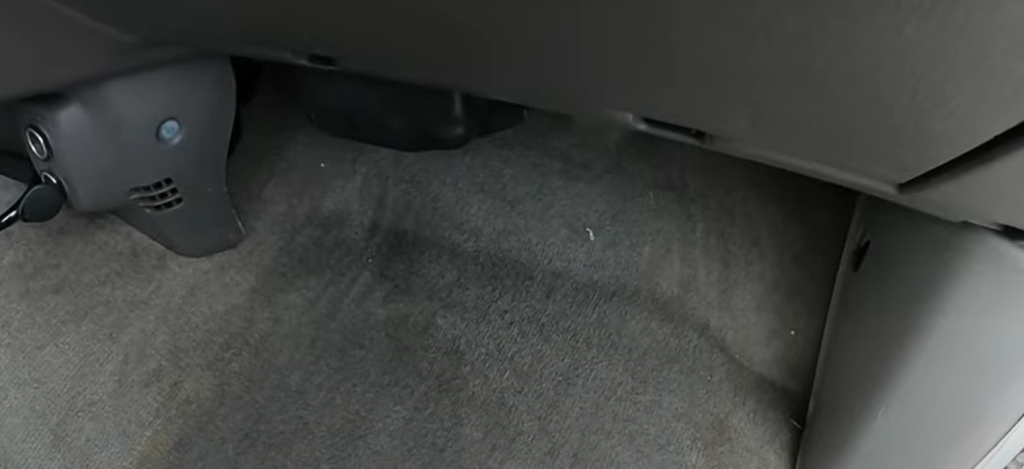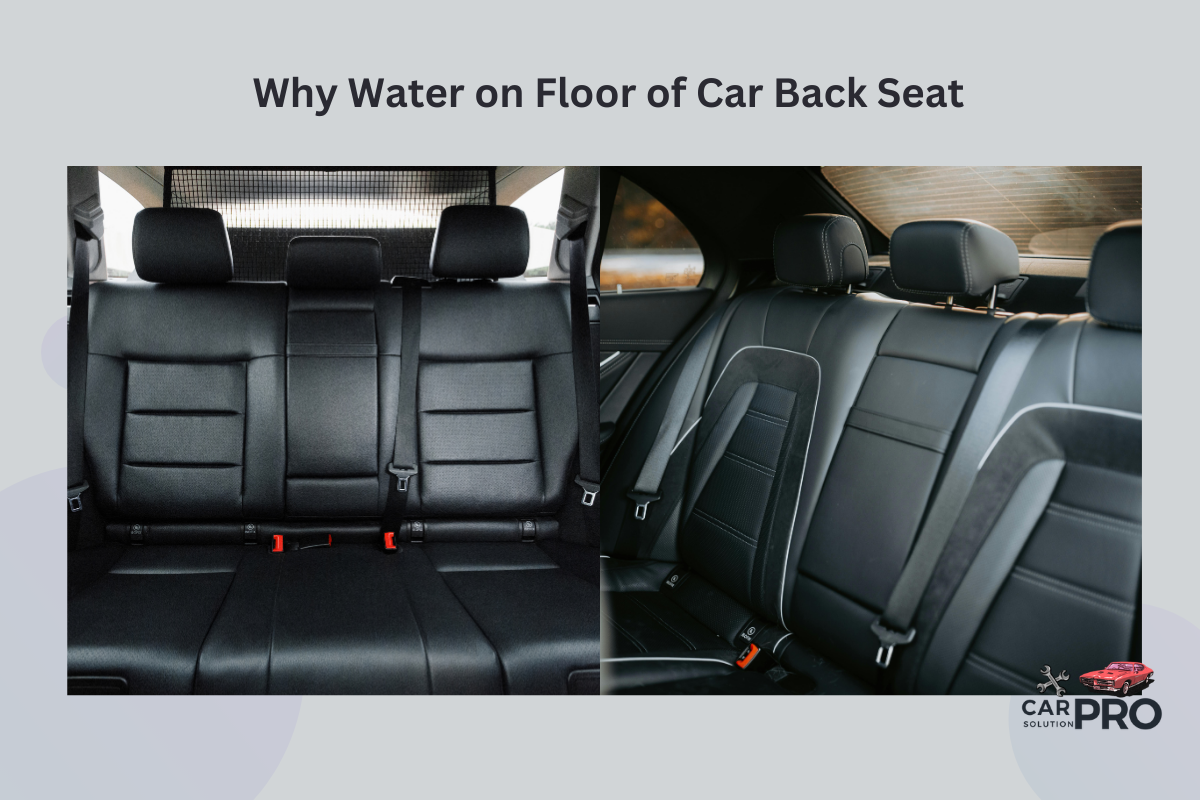Finding water on the floor of your car’s back seat can be alarming. This unexpected moisture can lead to unpleasant odors, mold growth, and even damage to your vehicle’s interior. Water accumulation in the back seat area is often caused by leaks from the sunroof, doors, or windows, as well as issues with the air conditioning system or heater core.
Fixing this problem starts with identifying the source of the leak. Clogged sunroof drainage holes are a common culprit, allowing water to enter the cabin instead of draining properly. Other potential causes include worn door seals, cracked windows, or malfunctioning air conditioning components.
Once you’ve found the source, you can take steps to fix the issue and prevent future water accumulation. This may involve clearing drainage channels, replacing seals, or repairing damaged components. In some cases, you might need to seek help from a professional mechanic to fully resolve the problem.
Key Takeaways
- Water on the back seat floor often comes from leaks or faulty car systems
- Identifying the source of the leak is crucial for fixing the problem
- Regular maintenance can help prevent water accumulation issues
Causes of Water Accumulation
Water on the back seat floor of a car can come from several sources. These issues can be related to weather, car systems, or drainage problems.
Weather-Related Leakage
Rain and snow can lead to water in the car’s back seat area. Leaky sunroofs are a common culprit. The sunroof’s drain holes can get clogged with leaves or debris, causing water to back up and enter the cabin.
Faulty door seals can also let water in. When these rubber seals wear out or get damaged, they don’t keep water out as well.
Windows that don’t close properly can be another entry point for water. Even a small gap can allow rain to seep in over time.
Car Heater Issues
Problems with the car’s heating system can cause water to appear on the floor. A leaking heater core is often to blame.
The heater core is like a small radiator. It can develop cracks or holes, letting coolant leak into the car’s interior.
This leaked coolant often ends up on the floor, especially in the back seat area. It may have a sweet smell and feel slippery.
Blocked Drain Tubes
Cars have built-in drainage systems to remove water. When these get blocked, water can pool inside the vehicle.
Clogged sunroof drains are a frequent issue. These small tubes can get filled with dirt or debris over time.
The air conditioning system also has a drain tube. If it gets blocked, water that normally drips outside can end up inside the car.
Leaves and debris can block the drainage channels around the windshield too. This can cause water to back up and enter the car’s interior.
Troubleshooting Water Entry
Finding the source of water in your car’s back seat can be tricky. Let’s look at key areas to check and how to fix common problems.
Inspecting Seals and Gaskets
Start by checking the sunroof tray. Leaves and debris can clog its drain holes. This forces water into the car’s cabin.
Clean out any blockages you find. Use a wire or compressed air to clear the drains.
Next, examine the trunk seal. A damaged seal lets water seep in. Look for cracks or gaps.
Replace worn seals promptly. Apply a rubber conditioner to keep seals flexible.
Checking for Windshield Leaks
Poorly fitted windshields can cause leaks. Check for gaps or loose areas around the edges.
Look for water stains on the dashboard or headliner. These hint at windshield issues.
Test for leaks by spraying water on the windshield. Have someone inside watch for water entry.
If you find a leak, have a professional reseal or replace the windshield. DIY fixes often fail.
Verifying Door and Window Seals
Inspect door seals for damage or wear. Press on them to check for good contact all around.
Roll windows up and down. Listen for air leaks that could let water in.
Check window channels for debris. Clean them out to ensure proper sealing.
Test door drainage holes. Pour water in and watch it exit underneath. Clear any clogs.
Replace damaged door or window seals. Adjust door alignment if needed for a tight fit.
Preventative Measures
Keeping your car’s interior dry requires regular upkeep and smart protection strategies. These steps can help prevent water from pooling on your back seat floor.
Regular Maintenance
Check your car’s seals and weatherstripping often. Look for cracks or wear in door and window seals. Replace damaged seals right away.
Clean out sunroof drains yearly. Use compressed air or a wire to clear debris. This stops water from backing up into the car.
Inspect the air conditioner’s drain tube for clogs. A blocked tube can cause water to leak inside. Clear any blockages you find.
Test your car’s drainage system. Pour water over closed doors and sunroof. Make sure it flows out properly. Fix any areas where water pools or leaks in.
Proper Vehicle Storage
Park your car in a garage when possible. This shields it from rain and snow.
If you don’t have a garage, pick a spot with good drainage. Avoid low areas where water collects.
Park on a slight incline when you can. This helps water run off instead of pooling around your car.
After heavy rain, open your car doors for a few minutes. This lets trapped moisture escape and prevents mold growth.
Using Waterproof Car Covers

Invest in a high-quality, waterproof car cover. Look for one that fits your car model well.
Make sure the cover is breathable. This stops moisture from getting trapped underneath.
Use the cover when parking outside for long periods. It adds an extra layer of protection against rain and snow.
Remove leaves and debris before putting on the cover. This prevents scratches and stops water from seeping through.
Secure the cover properly. Use straps or tie-downs to keep it in place during windy weather.
Cleaning and Repairing After Leakage
Dealing with water on the floor of your car’s back seat requires quick action. Proper drying, component replacement, and professional cleaning can prevent long-term damage and mold growth.
Drying the Affected Area
Start by removing all items from the wet area. Use towels to soak up as much water as possible. A wet/dry vacuum can help extract water from carpets and upholstery.
Open all doors and windows to increase air circulation. Place fans inside the car to speed up drying. Dehumidifiers can also help remove moisture from the air.
For stubborn wet spots, sprinkle baking soda on the area. Let it sit for several hours before vacuuming. This absorbs moisture and helps eliminate odors.
Check under the carpet for any standing water. Lift the edges and use a towel to dry underneath. This prevents water from seeping into the car’s frame.
Removing and Replacing Damaged Components
Inspect the carpet padding. If it’s soaked, it may need replacement to prevent mold. Carefully remove the carpet to access the padding.
Check seat belts and electrical components for water damage. Replace any corroded parts to ensure safety and proper function.
Look for rust on metal surfaces. Sand and treat these areas to prevent further corrosion. Apply a rust inhibitor for added protection.
Examine door seals and weatherstripping. Replace any worn or damaged seals to prevent future leaks. This is crucial for maintaining a dry interior.
Professional Cleaning Services
For extensive water damage, consider professional help. Auto detailing experts have specialized equipment for thorough drying and cleaning.
They can use industrial-strength dehumidifiers and air movers to dry hard-to-reach areas. This reduces the risk of mold and mildew growth.
Professional cleaners can apply antimicrobial treatments to prevent fungal growth. They also have the tools to deep clean and deodorize carpets and upholstery.
Many services offer ozone treatments. This can eliminate stubborn odors caused by water damage. It’s especially useful for cars with lingering musty smells.
When to Seek Professional Help
Sometimes car water leaks are too complex for DIY fixes. Professional mechanics have specialized tools and expertise to diagnose tricky leaks and make lasting repairs. Here are key times to get expert help:
Complex Leak Diagnostics
Water leaks can be hard to find. Pros use methods like UV dye tests to pinpoint hidden leaks. They check areas most car owners can’t access easily.
Mechanics also have pressure testers to find tiny cracks in the windshield seal or sunroof drains. These tools help spot leaks that only show up in heavy rain or car washes.
For electrical issues linked to water damage, pros use scan tools. These find faults in door modules or other electronics affected by moisture.
In-Depth Car Inspections
Expert mechanics do full inspections to find all leak sources. They check weatherstripping, body seams, and drain holes.
They also inspect the heater core and air conditioner for internal leaks. These can cause wet floors but are hard to spot without taking parts out.
Pros look at the whole car, not just wet spots. They might find rust or damage that lets water in. This full check helps fix current leaks and prevent future ones.
Long-Term Solutions and Repairs
Professional repairs last longer than quick fixes. Mechanics use the right tools and parts for each job.
For sunroof leaks, they might clean out drains or replace seals. They know how to take things apart without causing more damage.
Body shops can fix rust spots that let water in. They use proper paints and sealants to stop leaks for good.
Pros also know when to replace parts instead of just patching them. This stops leaks from coming back later.
Frequently Asked Questions
Water on the back seat floor of a car can be concerning. There are several potential causes and solutions to address this issue.
What causes water to accumulate on the back seat floor of a vehicle?
Water can accumulate due to leaks in the sunroof, damaged weather stripping, or clogged drain holes. Faulty door seals may also allow water to enter the vehicle during rainy weather.
How do I address water leakage onto the back seat floor of my car?
To address leaks, inspect and clean drain holes regularly. Replace damaged weather stripping around doors and windows. Check the sunroof for proper sealing and ensure its drains are clear.
What steps should I take if I find the back seat floor wet after rain?
If the floor is wet after rain, dry the area thoroughly. Look for visible leaks around doors, windows, and the sunroof. Check the car’s drainage systems for blockages and clear them if necessary.
Why might there be a puddle of water in the back passenger footwell?
A puddle in the back passenger footwell could be caused by a malfunctioning air conditioner evaporator or heater core. It may also result from water entering through a damaged door seal or floor pan.
What are common issues that lead to water under the passenger seat?
Common issues include clogged air conditioning drain lines, leaking windshield seals, and damaged body seams. Improperly sealed exterior lights can also allow water to enter the vehicle.
How can I diagnose the source of wetness on my car’s back seat floor?
To diagnose the source, check for visible leaks during or after rain. Inspect seals around doors, windows, and the sunroof. Look for signs of rust or water stains, which can indicate long-term leaks.



